How A Well-Stocked Pantry Can Save You Money
You can whip up inexpensive meals in a flash if you have the basic core ingredients on hand. Check out these easy ideas and stock up!
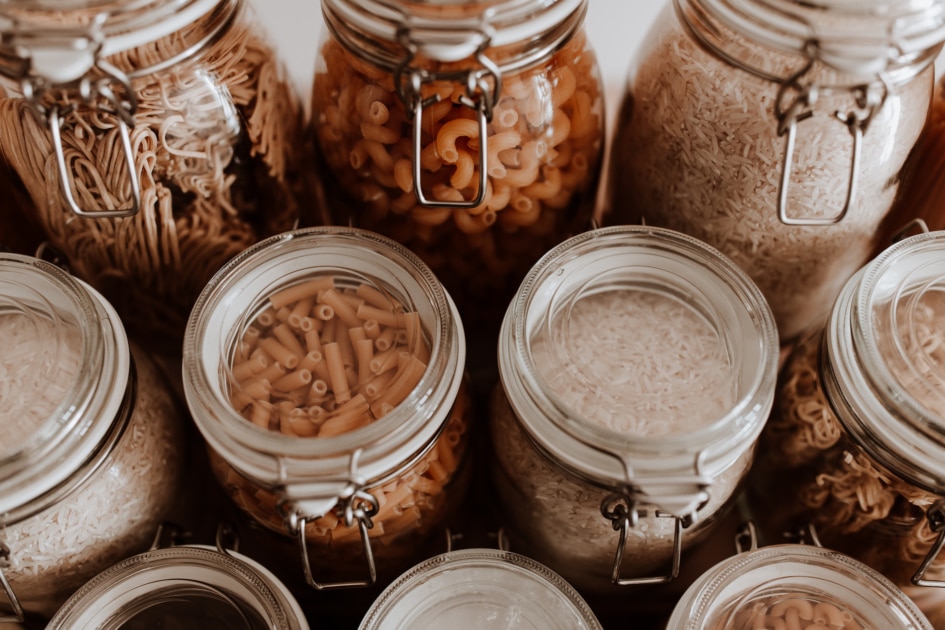
The average person in America household spends about $3,500 on take-out food each year, and most admit it’s because they don’t have the energy to plan, shop, and cook each night. But with the right staple ingredients within reach, you’re more apt to eat in if you know you can throw together a satisfying meal in minutes.
So put down your phone and put away that delivery menu! Our tips will help you get your pantry stocked with all the basics you need to cook healthy and delicious meals in a flash. The delivery people will miss seeing you, but they’ll understand!
1. Grains
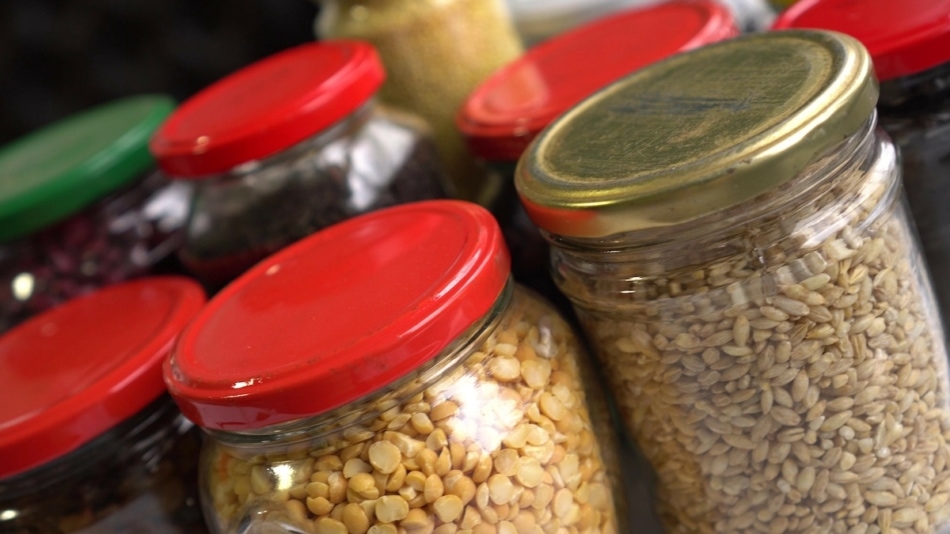
The variety of grains available to the regular consumer is pretty impressive: brown rice, black rice, wild rice; then there’s quinoa, barley, tabouleh, freekeh, and farro, and many more centuries-old grains that are now power-food trends. Decide on a few favorites to keep on hand for salads, soups, and side dishes, and keep them in labeled, screw-top jars to preserve freshness (buying them in bulk is the most cost-effective way to purchase grains). They’re inexpensive and quick to cook, plus super-nutritious and delicious.
2. Pasta
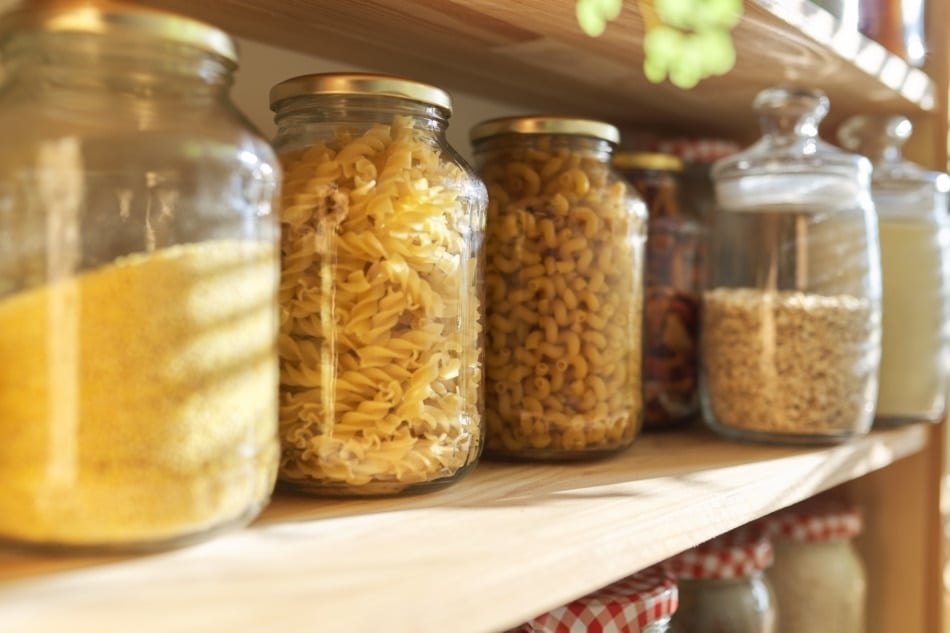
There are so many shapes, sizes, and flavors of pasta to choose from. You can whip up penne tossed with spinach and pine nuts one night, or a simple and savory couscous another night. Each has a very different flavor and texture to satisfy and add variety. And all come straight from your pantry. Plus, they’re inexpensive. Stock up on assorted varieties when they go on sale.
3. Legumes
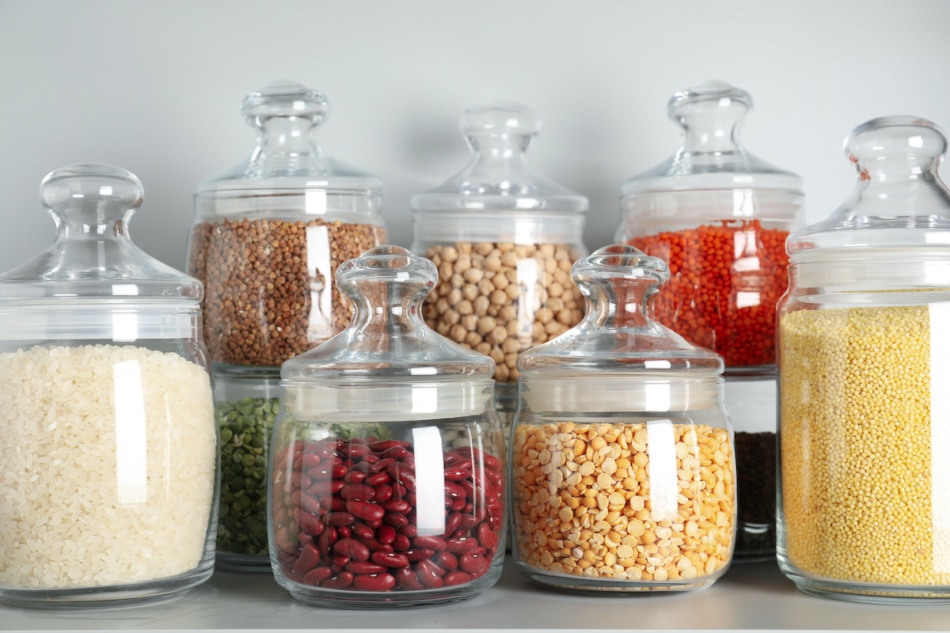
Legumes are fast and easy to add to soups or create side dishes. They’re packed with protein and fiber while being inexpensive and filling. Flavorful and easy-to-make black beans and rice is a no-brainer when you’re on a budget. Watch the circulars and fliers for when cans go on sale. And store brands are just as delicious and nutritious as brand names and are usually a fraction of the cost.
Dried varieties—beans, peas, and lentils—are also excellent to have on hand, stored in labeled, air-tight jars. And if you’re not sure how to prepare beans or need new ideas to keep your family happy, we have are many wonderful recipes on our website to try!
4. The Can-Can
Obviously, including protein in your daily meals is important.
- Chicken, tuna, anchovies, sardines, and salmon in your cupboard will liven up and add a healthy boost to any pasta dish or salad. Canned fish is good for the body, brain, and budget. Have canned smoked mussels or sardines you’re not sure what to do with? With just a dollop of mayo, some chopped onions, a splash of vinegar, and a touch of salt, you have a quick cracker-topping for hors d’oeuvres for impromptu guests that is rich in protein and omega 3s. And to think you just pulled that out of the pantry!
- Tomatoes: sauce and paste, chopped, whole and crushed. They’re inexpensive, nutritious and loaded with antioxidants (canned tomatoes are an excellent source of lycopene). Having one or all of these on hand makes satisfying chilis, sauces, and soups just a can-opener away.
- Canned Beans – In addition to dried beans, above, stock up on cans of black beans, chickpeas, and kidney beans. One of the most versatile varieties of beans is cannellini, also known as white kidney beans. Great in soups, dips, or eaten straight out of the can, they can be used in many recipes. Toss them with drained tuna, olive oil, a pinch of salt, a splash of vinegar, maybe some chopped onions and capers, and you have a quick Mediterranean meal that is pleasing to both the palate and the purse!
If you do your own canning after a bountiful garden crop, you know the value of having these gems on hand: tomatoes, okra, pickles, relishes, green beans, applesauce and more. Another reason to grow your own food—you can enjoy the bounties well beyond the growing season and keep food on the table year-round.
Be sure to mark cans with expiration dates and rotate them with new items as you stock the shelves.
5. In The Freezer
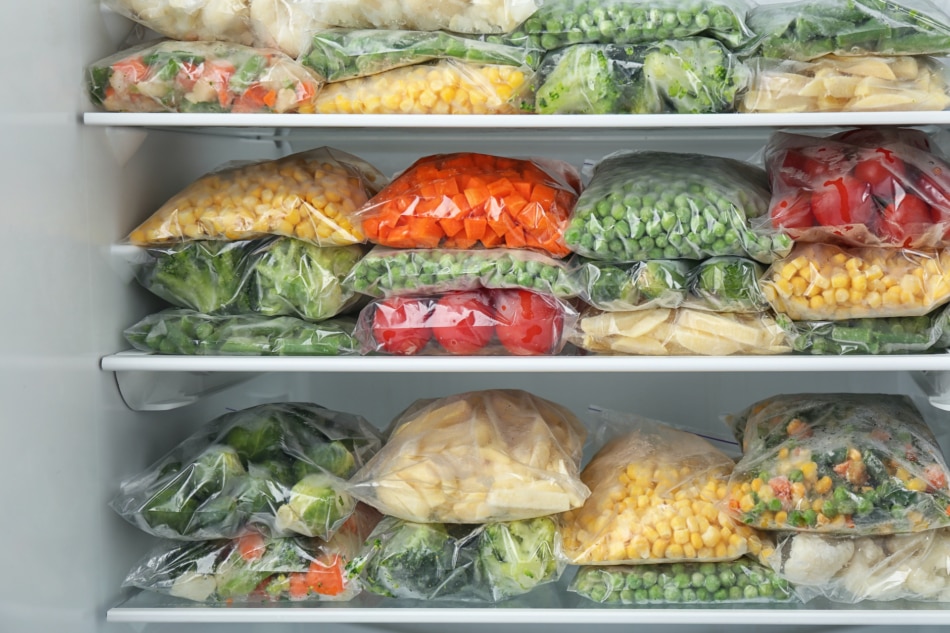
Expand the concept of the pantry to include your freezer for fish and meat when you’re in the mood. When frozen items go on sale, stock up. It’s a wonderful thing to have a bag of shrimp in your freezer at all times—you can whip up a meal, an appetizer, or a late-night snack that is low-calorie and delicious, fast, and affordable.
Also, keeping a stock of organic frozen veggies is a revelation. They’re clean and chopped and ready to throw into a pasta dish, soup, stir-fry, or as a side dish. Plus freezing locks in nutrients. The same goes for fruits. Buy cartons of strawberries and blueberries when they’re on sale, wash, and prep them, then throw them in the freezer to use in smoothies, lemonade on the patio, or for a quick, cool dessert.
See our tips for freezing food the right way here.
6. Condiments and Miscellaneous

Other pantry must-haves include:
- Soup stocks and broth: chicken, beef, and vegetable.
- Vinegars: red wine, rice wine, apple cider, balsamic.
- Oils: avoid over-processed canola and vegetable oils and invest in cold-pressed olive oil, virgin coconut oil, or avocado oil. They may cost a little more, but a little goes a long way.
- Olives: They perk up any salad or pasta dish with loads of flavor while adding healthy fats.
- Nuts: raw, roasted, toasted or baked, to add crunch to salads, and make pestos. Be sure to keep them in airtight jars.
- Sauces: Honey, molasses, Worcestershire, mustard, soy sauce, Sriracha
- Potatoes, onions, and garlic. Use a wooden crate or box to store them off the floor.
By keeping your pantry well-stocked, you’re keeping your kitchen full of non-perishable possibilities that can create a variety of inexpensive and healthy meals out of some basic core ingredients.

Christina Carr
Christina Carr is a freelance writer and television producer who has worked for NASA, PBS and John Edward, the psychic medium. She is a proponent of sustainable and healthy living, and lives in NYC with her 4-year-old daughter and musician husband.

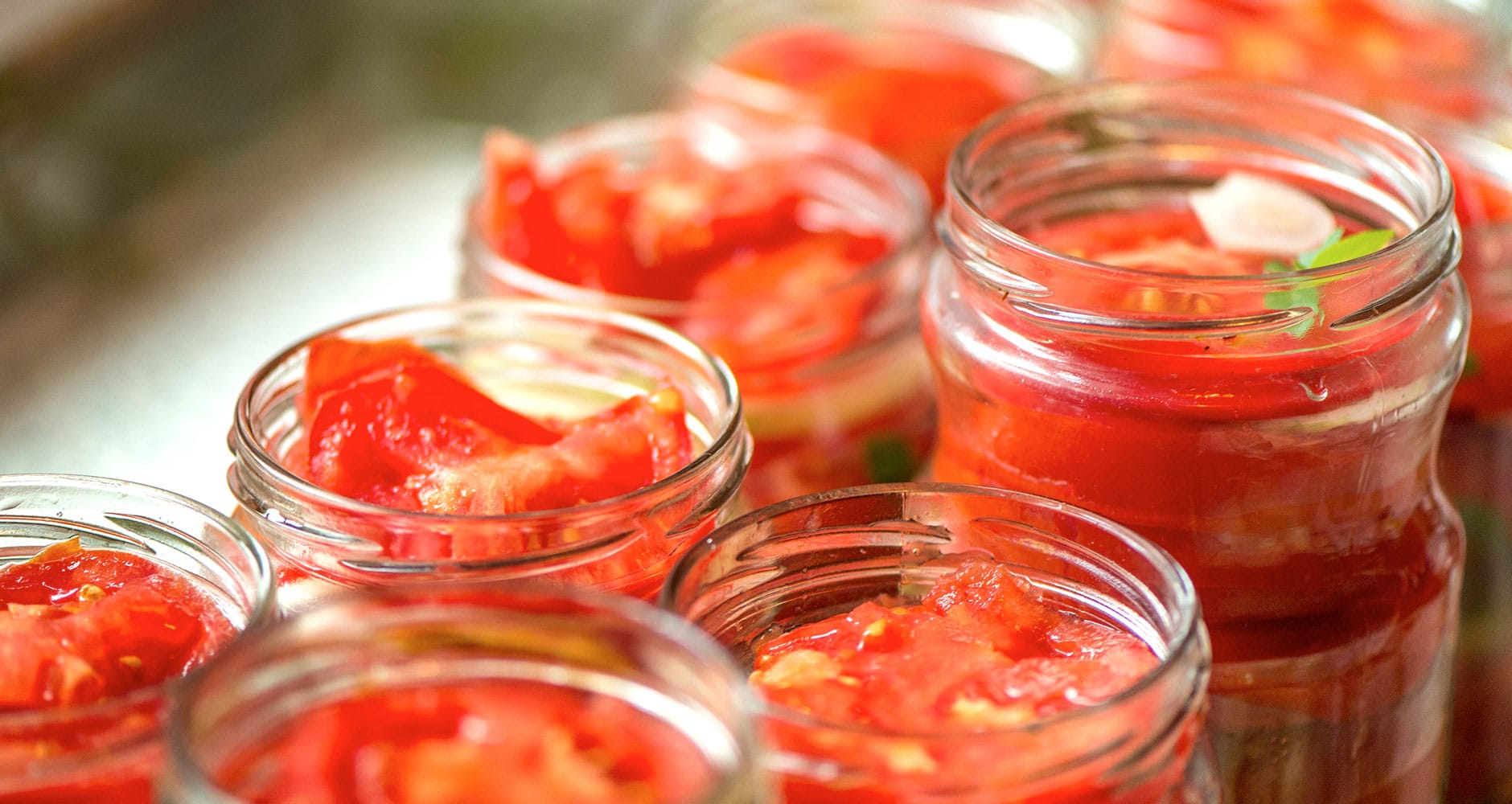




Seeing that prices were going way up, a year ago I started a ‘stocking’ program of my own as we’re on a very limited income. I put up veggies in freezer jars (no drying out), raised some herbs in flower pots and dried them. I used (and still do) coupons for items I use–I do not buy an item just because a coupon is available, but I have ‘tried’ a few things for the first time. When I shopped I gradually added ‘extras’ with long expiration dates that were on sale if I had coupons. I now have a large complete stock of most ‘everything’ I use–I just buy replacements of what I have used, I keep a ‘running’ list-I add what I use & when they go on sale I buy–then remove from the ‘running grocery list’.. It has paid off now as our grocery bill is between $200-$250 monthly including animal food, etc. I store dry goods in the freezer after bagging,& canned goods, mixes/etc are stacked in flats behind a sleeper sofa in a spare bedroom, in a converted linen closet & a tall free-standing cabinet my husband made. I am fortunate to have the room & extra freezer as it has paid off greatly. My big secret is that I have a complete ‘running inventory’ of everything so I know if I am low on something. The running grocery list of items I use is a MUST! Organization is the key–but once set up works smoothly.
Why r u keeping ur dried good in freezer long-term? Is it just a place to stay them? I have friends who have pace her a good grade 5 gal buckets from Walmart approx $5, bucket <$3 & lid <$2. Then she'll decorate them w wrapping paper, repurpose old clothes then she turns them into furniture. She's out passed seats on them which worked perfect for the young kids. She layered flattened cardboard boxes making a round table top that day on top of another bucket (she raised it several inches) so now the kids had at table using repulsed material& did buckets. She made end tables & coffee tables, night stand her husband made toys w wood. The craziest of all was 1 yr she made Christmas tree using different foodstorage containers. Yes, it was pretty ugly, but one of those ugly things that r so cool u live them. So be creative , people pay allot of money to have some fancy glass jar of canned goods that just sits on the shelf.
I only use dried beans, grains & lentils. 8 generally have minimum 25lbs on hand. I never freeze any dry food b4 storage & I've never had problem, I'm 57 & have all over US & outside country. I have everything in glad jars up to 2 gal reading available then everything else in 5 gal buckets. For the beans & lentils I always use together in my soups I'll mix upto 1/2 gal, it very pretty on my floating shelf. Otherwise only store like beans together sure to different amount of oil they can get rancid. I purchased a Food Saver canning lid vacuum $25 that works on 1/2 gal – 14 oz. It might work on 4oz jelly (which is good to store herbs in when u buy in bulk & remember never store herbs/ seasoning where sunlight can hit them) & 8 oz. The jar lid sealer does require a Food Saver seal machine. I really like the vacuum seal machine, I buy meat in bulk so this way I can package them to my needs. With that said, one broke in 2 so u purchased another & it broke 1 yr later right after warranty expired. They do have videos on u tube that show u how to make a hand pump from $10 parts from Auto store.
My newest addition to my kitchen approx 14 no ago when soon came home due to Covid was a 8qt Insta Pot. I've never been a gadget kitchen I'm very old school. Totally reminding my 1943 bungalow I was too exhausted to cook let alone try to remember to take dry beans or night b4. I'm still blown away that I can put dried beans in a pot & b sitting down eating dinner within the hour.
Have fun learning how to have a quality pantry full of wonderful real food!! This is a good time to have 6 mo food sucked up. Remember u need to have ur treats also, chocolate, honey, hands, marshmallows,…. Girl can't go without chocolate during socialist ;}
I hear you, Missy. Not only do I live in a tiny nyc apartment (with a tiny kitchen), but we are a family of freelancers (so we have to watch our pennies). ‘Stocking up’ isn’t about buying everything on this list, all at once. I don’t have the money or space to do that either! But if you do have a few go-to recipes that your family loves, it saves money in the long run to have some of those ingredients on-hand. Tonight I looked in my fridge and saw nothing; some yogurt and condiments and a small piece of leftover chicken. Slim pickins fer sure. Ordering in – or grocery shopping – weren’t options. What did I do? I made rice (a long-grain/quinoa combo that i try to always have in the cupboard) and veggies (from the freezer), and that one old carrot from the vegetable drawer, along with the leftover chicken. I added some chopped fresh parsley from the plant growing here in the kitchen – and a splash of hot sauce (another staple) – and i had a quick and easy and yummy and filling meal – possible because I had those things in my pantry.
I guess there will always be “victims” with excuses. I read this article & saw a great way to save money (a good thing for any income level). I guess where there’s a will, there’s a way.. Everyone else will just “have to” keep eating Big Macs. Smh
I love this idea. It sounds so easy and it is. Thank you so much. We make it so hard when it isn’t.
While this sounds like a great idea. There are some of us that cannot do this simply because we do not have the means. Such as my family are still building our house.
And we do not have room to stockpile food every where while we are living in parts of
the house and other parts are still being built which can talk a long time. Or those of us
that live in small apartments that do not have the space. Lower income paychecks. Not all of us have the means to do this kind of thing. As well how a person gets paid monthly vs a few weeks at a time means living by our means a person may have to pay for food weekly because of how they get there check vs being able to save up when the means are not there to save in the frist place.
Also a staple in my kitchen is an assortment of flours and herbs. One or two good cookbooks are always handy as well.
Not only will it save you money, but when a crisis/disaster happens (man made or a natural disaster) – you will have peace of mind and food security for your family. I would also suggest some dry milk and dried eggs – you can whip up last minute desserts with those two items and the pantry & freezer items listed above.